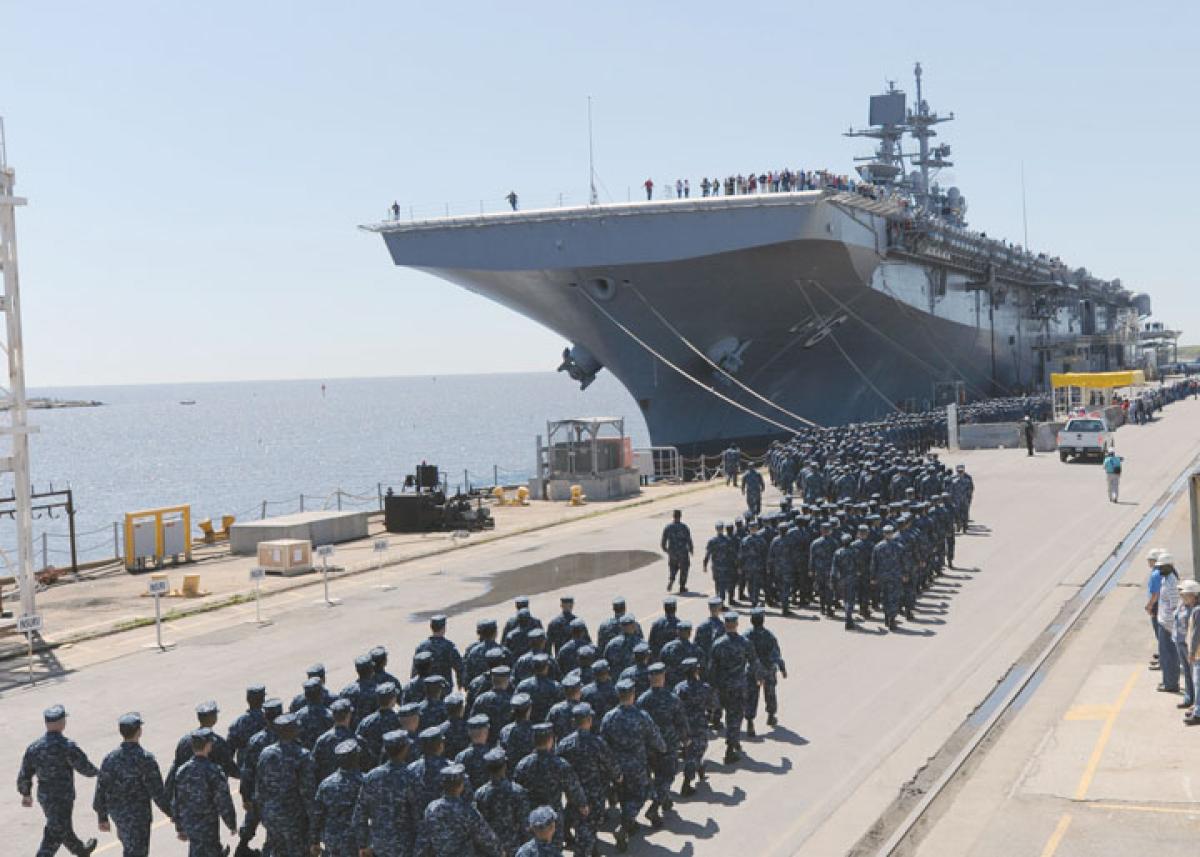At times during the past couple of years, U.S. carrier battle groups have been forward deployed for nine- and ten-month periods. Now the Navy plans to “lock in” eight-month deployments. The plan is intended to return “predictability” to deployments—which it is hoped will improve personnel retention.1
Reaching the eight-month deployment goal will not be easy. Commander, Fleet Forces Command, Admiral William Gortney, speaking at the Navy League’s symposium at National Harbor, Maryland, in April, declared, “Eight months is right on the ragged edge of what’s acceptable,” and added that several factors were working against it.
Earlier, Admiral Gortney had announced his Optimized Fleet Response Plan that outlined the goals that must be met for the eight-month cycle, including putting all ships and air units of a carrier strike group on the same maintenance and deployment schedule. This plan initially will focus on the carrier groups and eventually is to include all U.S. Navy ships and air units that deploy, including those from the amphibious ready groups, Marine Corps expeditionary units, and attack submarines.
At the same time, the Navy’s leadership laments the shrinking size of the Fleet, which has been a major factor in extending deployments from the “standard” six-month periods that existed for most of the Cold War and for the past two decades. The Fleet—“battle-force ships”—numbers 289 ships as this column is written (see accompanying table). But it soon will be reduced, so far as effective fleet units are counted, as the Navy decommissions several Aegis missile cruisers, a couple of amphibious ships, and the last of the frigates during the next year or two. The “numbers game” could see the totals remain about the same as shipyards produce littoral combat ships (LCSs) and joint high-speed vessels (JHSVs). And the Navy is reconsidering how it counts “battle-force” ships.
When counting ships the LCS cannot be considered as a replacement for an Aegis cruiser or even a frigate in terms of inherent capabilities. This is especially true because of the specialized mission configurations of the LCS, although none of the planned mission modules that make the LCS a “warship” is ready for production. While the JHSVs are very useful for moving troops at high speeds in forward areas, they lack the cargo capacity and docking well, and other features of the dock landing ships (LSDs) that are about to be retired. Further, unlike the LSDs, they cannot accommodate troops for periods longer than a few days.
The Aegis cruisers that are being retired are highly capable warships. Each has 122 vertical-launch cells that can accommodate antiair, anti-ballistic-missile, and land-attack missiles. In addition, those ships have two 5-inch guns, carry two MH-60R helicopters, and have a good antisubmarine capability. Could retaining these ships in the active Fleet permit one (or several) cruisers to operate in certain areas where carriers normally deploy?
While the capabilities of these ships differ, the cruisers can conduct long-range precision strikes (out to approximately 1,000 miles, much farther than the F/A-18 Hornets on board carriers can reach). Also, when updated, the cruisers have a potent ballistic-missile-defense capability.
Meanwhile, there may be a major shift in the LCS program, one that could provide the Fleet with frigate-type warships in place of a number of the littoral combat ships with specialized-mission modules. On 24 February, Secretary of Defense Chuck Hagel directed the Navy to assess new options for procuring a more capable and lethal “small” surface combatant.2 His focus was on the Navy’s current program of 52 LCSs, placing at least a temporary hold on the program at no more than 32 ships. (When initiated several years ago the goal was 55 LCSs.)
Secretary Hagel directed the Navy to submit in time to affect the 2016 budget deliberations alternative proposals to procure a “capable and lethal small surface combatant, generally consistent with the capabilities of a frigate.”3 Options to be looked at by the Navy were a completely new ship design, the existing LCS design “up-gunned,” and a modified LCS.
A frigate-like warship could greatly impact the ship-numbers game. A new-design frigate probably would take more than a decade for developing, designing, and building a prototype. Up-gunning the current LCS is a favorable approach. But most promising would be a modified LCS—taking advantage of the large number of U.S. and foreign sensors and weapon systems that are readily available. Further, a ship of this type could find customers for U.S. shipyards and systems suppliers in several foreign navies.
The Navy is expected to submit recommendations for the “new” warship this summer, in time for development of the Fiscal Year 2016 budget development. As previously expressed in this column, frigate-type ships are needed by the U.S. Navy to complement the “high-end” Aegis/vertical-launch battery cruisers and destroyers. And frigates will help provide the numbers of multimission warships in low/moderate-threat areas where presence and confrontation requirements will continue to occur around the world.
1. Lance M. Bacon, “Fleet’s new deployment plan to lock in 8-month cruises,” Navy Times, 14 April 2014, 16–17.
2. Office of the Secretary of Defense, “Memorandum for Secretary of Navy and Chief of Naval Operations, Subject: Littoral Combat Ship (LCS) Program,” 24 February 2014.
3. See Norman Polmar, “Where are the Frigates?” U.S. Naval Institute Proceedings, vol. 139, no. 6 (June 2013), 86–87.
Battle Force Ships, April 2014
CVN aircraft carriers 10
CG cruisers 22
DDG destroyers 62
FFG frigates 8
LCS littoral combat ships 4
SSBN Trident submarines 14
SSGN guided-missile submarines 4
SSN attack submarines 54
LCC command ships 2
--- amphibious ships 29
MCM mine-warfare ships 8
PC combat craft 8
--- combat-logistics ships 31
--- fleet-support ships 25
--- auxiliary-support ships 3
FFG Naval Reserve 5



